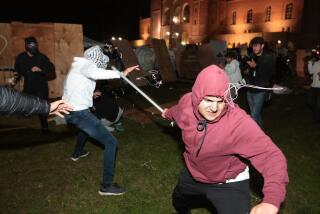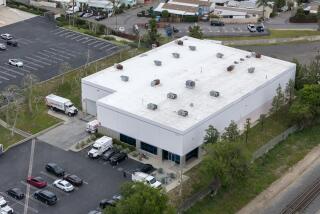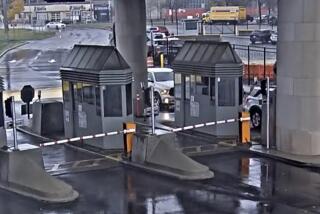U.S. Tackling Blast Probe on Unprecedented Scale
WASHINGTON — Even as office workers in the World Trade Center were trying to pry their way out of stalled elevators or stagger down smoky stairwells in the wake of a devastating explosion last Friday, a special team of men and women were leaving FBI headquarters here for the next flight to New York.
Within hours, telephones, telexes and computer screens at American embassies around the world began receiving urgent messages, asking officials to cull their files and foreign sources for useful information.
In a room filled with banks of cream-colored computer equipment at the CIA’s compound in suburban Virginia, technicians already were searching for similar modus operandi based on the initial fragmentary data.
New clues and evidence unearthed at the scene were added immediately to a sophisticated database to help identify patterns or methods of operations used by suspect organizations from around the world.
The explosion, which killed five people and injured more than 1,000, had triggered the nation’s little-known but elaborate anti-terrorism machinery. And it had done so on an unprecedented scale.
About a decade ago, the government, concerned by the potent terrorism capabilities of anti-American groups in a number of countries, began expanding and improving its plans, training and equipment for protection against such an attack.
As U.S. administrations ordered bombing attacks on Libya, promoted peace talks in the Middle East and took military action in the Persian Gulf, fears surged again and again that the plans were about to be put to the test. Each time, it didn’t happen, either because the FBI had thwarted a terrorist attempt or because the feared attempt never occurred.
But during lunch hour in Manhattan last Friday, that string of good fortune seemed suddenly in doubt as government fears grew that terrorists may have struck on American soil. Thousands of people and dozens of agencies here and abroad sprang into action.
“I don’t think I’ve ever seen anything bigger, except maybe the (John F.) Kennedy assassination,” said one counterterrorism official.
The investigation may not finally conclude that the blast was the work of international terrorists--or succeed in establishing the cause at all--but the extraordinary process provides a rare view of the government’s answer to the question of what the United States should do if its enemies attempt to strike the nation at home.
Stated simply, the plan calls for bringing together information and theories from the intelligence community with the findings from a traditional criminal investigation.
“When you get the two together, with the intelligence information crossing with that of the investigation, you’ve solved your case,” a U.S. counterterrorism official said.
“It’s critical not to hold on to one theory and to pursue it to the exclusion of other theories,” an FBI official said. “Otherwise, you’d have to start over.”
“We’ve jumped to conclusions on earlier cases,” another counterterrorism official said, citing the investigation of the December, 1988, bombing of Pan American Airways Flight 103, which killed 270 people on the New York-bound flight and on the ground in Lockerbie, Scotland.
For more than the first year of that inquiry, the focus was on Iran and Syria using radical Palestinian operatives in retaliation for the 1988 U.S. downing of an Iranian Airbus. Almost 18 months passed before the focus of the investigation shifted to Libyan agents acting in retaliation for the 1986 U.S. bombing of their country. Two Libyan agents have been indicted but Libya has refused to extradite them for trial.
Today, six days after the New York blast, “we’re pursuing a wide range of theories, knowing that the most critical part of the examination is still to be completed,” an FBI counterterrorism official said. He referred to the inability of investigators--because of the need to shore up the site--to reach ground zero of the explosion to sift debris for tell-tale evidence, an objective that is not expected to be reached before the end of the week.
By Wednesday, investigators at the scene had narrowed the center of the explosion to one of the garage’s parking ramps. Authorities said that location was determined partly by dropping a plumb line into the huge crater made by the explosion.
Experts said that they are not yet sure whether a vehicle believed to have carried the bomb was moving or parked at the time.
FBI officials contrast the task they face collecting evidence in the damaged garage with the obstacles confronting investigators of Pan Am 103, when evidence was scattered over 845 square miles.
While the garage is contained, it has the added danger of evidence having been washed away or diluted by the water used to quell the blaze that followed the explosion.
“It will take several months before the forensic aspects are completed,” an FBI official said.
Even though technicians have not gained access to the “hole,” as the cavern left by the powerful explosion has been dubbed, FBI agents working with the New York Police Department and Treasury’s alcohol, tobacco and firearms specialists are collecting for analysis evidence from hundreds of cars destroyed or damaged by the blast.
Some 200 vehicles, or the remains of them, are being towed from the site but not before they are vacuumed inside and out--with the recovered material being placed in a separate plastic residue bag for each car.
“Nothing will go out of that garage without being examined,” an FBI official said.
Agents are interviewing the hundreds of drivers of the cars for what they might have seen and attempting to place each vehicle in the spot it occupied in the garage.
The team of FBI information management specialists, who flew to New York the day of the blast, is recording in computers every piece of data to ensure that it can be speedily located, retrieved and linked to other relevant information.
L. Paul Bremer, ranking State Department counterterrorism official during much of the Ronald Reagan Administration, described the process being followed in the New York inquiry as “ECM--for evidence, capabilities and motive.”
The evidence collection and analysis seeks to establish the kind of bomb used, including the timer and type of explosive, which could bear the signature of a device favored by a particular group or individual.
On capabilities, Bremer said, investigators look at the method of operation and determine which domestic and foreign groups have shown a similar capability and the skill to carry out a large-scale bomb attack.
“There are not that many” groups capable of such an attack, he noted, listing Colombian drug lords, the Irish Republican Army, Sendero Luminoso (Shining Path) Peruvian terrorists, and Hezbollah, the pro-Iranian Shiite extremists, as among the groups which could perform such a mission.
“You can pretty much count out Sendero, which acts only at home, and the IRA, because it won’t hit its U.S. pocketbook,” he said, referring to American contributors to the IRA.
Bremer added that the Serbs and Croats “can’t be eliminated” from the list of prospects, “and you have to hold out a 10% chance that it’s a disgruntled employee or wacko. It’s a pretty big bomb for a guy to do on his own but I’ve learned in terrorism that it’s not a surprise-free environment.”
In examining motive, “you look at who would benefit but you have to go back some length of time,” noted Graham Fuller, a former CIA analyst. “It could be an operational decision dating back a year that doesn’t have any relationship with immediate events.”
Bremer and other counterterrorism experts do not put much weight in what appears to be a lack of a credible claim of responsibility for the Trade Center blast.
“Lockerbie was not claimed, although I believe it was a straightforward revenge attack,” Bremer said.
If a foreign group, such as Hezbollah or Colombian drug lords were responsible, they could well remain silent while they eliminated those who carried out the bombing or sought to get them out of the United States, Bremer noted.
While all of the investigative activities are being carried out, an extensive review will be conducted of all intelligence collected over the last 12 months to “find out if, in light of the attack, some piece of intelligence already picked up, fits like the missing piece of a puzzle,” a counterterrorism expert said.
Intelligence also is flowing in from U.S. and foreign agencies that are cooperating in the investigation.
Times staff writers John J. Goldman and Robert L. Jackson contributed to this story from New York.
More to Read
Sign up for Essential California
The most important California stories and recommendations in your inbox every morning.
You may occasionally receive promotional content from the Los Angeles Times.










